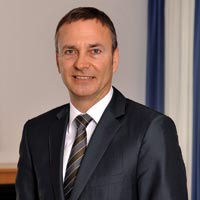A chart showing EADS's shareholdings on its formation 10 years ago looked like the sort of circuit board an electrical engineer would have trouble with. The outcome of a merger of three national industrial groups - in the rush to consolidate Europe's aerospace sector in the late 1990s - the ownership structure was muddied by the fact that within the German and especially French parent entities, different parties held sway.
Most of Germany's 30% share was held by automaker DaimlerChrysler (now Daimler), with the state of Hamburg also retaining a small stake in the original parent business, DaimlerChrysler Aerospace. Media giant Lagardère shared the French 30% with the French government. The latter had owned Aerospatiale, which owned the French part of Airbus. Latécoère had only just merged its recently acquired Matra defence business with the nationalised company to form Aerospatiale Matra.
|
|---|
NEUTRALITY
To complete the three-nation contractual partnership, which for reasons of neutrality was registered in the Netherlands, Spain took a 5.5% stake in EADS. State-owned CASA brought into the new business its decades-old specialism in small military transports - as well as facilities that already formed part of the Airbus and Eurocopter subassembly operations. An additional 30% of EADS shares were floated on three stock exchanges with a further 4% or so held by the main shareholders through different channels.
This intricate balance of shareholdings - mirrored by EADS's unorthodox French-German management structure, with co-chairmen and co-chief executives - was a product of the haste at which Arnaud Lagardère, founder of the French company, and his German counterpart, DaimlerChrysler's Jurgen Schrempp, drove the merger. They cajoled politicians to back their move and forced others, including BAE Systems and Alenia Aeronautica, to abandon or modify rival consolidation attempts.
Since 2000, the ownership chart has simplified. The main shareholders are the same, but both private companies have reduced their stakes so the overall French and German shareholding remains at 22.5% each. Latécoère's share has come down from 15% to 7.5%, while the French government has retained its 15%. On the German side, Daimler, in 2007, reduced its holding by 7.5% to 15%, but the 7.5% was handed to a consortium of German private and public sector investors with strict provisos about selling those shares on.
 Four independent directors also joined the 11-strong EADS board in 2007, including Anglo-Indian steel magnate Lakshmi Mittal and UK businessman Sir John Parker, giving it a more cosmopolitan feel than in its early years.
Four independent directors also joined the 11-strong EADS board in 2007, including Anglo-Indian steel magnate Lakshmi Mittal and UK businessman Sir John Parker, giving it a more cosmopolitan feel than in its early years.
Spain's 5.5% takes the three countries' shareholding to just over 50%, with the rest held by private shareholders. Tipping that free-float proportion over the half-way mark is a delicate issue for a company that was founded on the basis of shared French-German control. However, a likely scenario is that as French and German shareholders gradually reduce their shares further, they will retain a veto on any significant decisions.
However, without this legacy of strong but equal national shareholders EADS would never have got off the ground, acknowledges company chairman Bodo Uebber of Daimler. "EADS was only possible with such a balance in the shareholding and the management structure it created," he says. "We were doing something that had never been done before. With an imbalance, we would not have succeeded."
EADS remains the product of its politically inspired creation. Its French-German axis has its roots in the trans-Rhine alliance that formed the basis of the European Community, when peace between traditional enemies and a bullwark against US economic dominance were priorities for leaders such as Charles de Gaulle and Konrad Adenauer. However, even by the late 1990s, when industrial consolidation was essential to compete with the USA's new batch of mega contractors, the big European nations were still protective of their domestic aerospace champions. The marriage terms had to be carefully fixed.
But as EADS transitions to be a more global business, its French-German parentage is becoming its heritage rather than its driving philosophy. While it will remain a European company, over the next decade it will be the abilities and judgement of its executives, rather than the nationality of its shareholders, that will be the deciding factor in its success.
Source: Flight International














